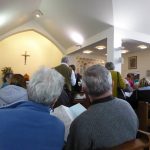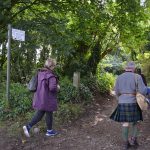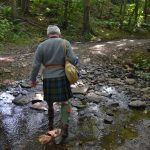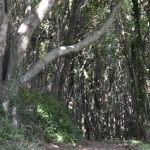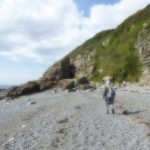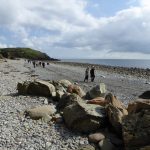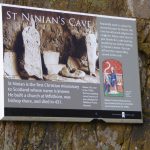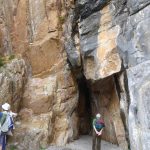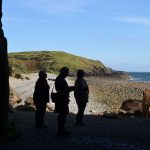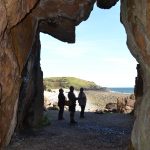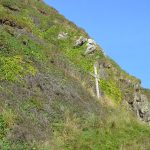Pilgrimage to Whithorn
On Saturday September 2nd– over 100 Episcopalians, their dogs and friends, from across the diocese gathered at St. Martin & St. Ninian’s RC church in Whithorn
We had a lovely service, Bishop. Gregor presided, Revd David acted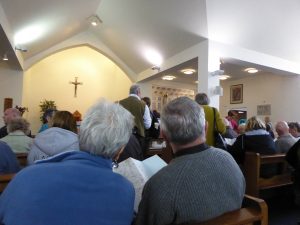 as Bishop’s Chaplain and Cantor – it was a sung eucharist with some new settings for the Mass which people picked up on quite quickly. The Bishop’s address was about pilgrimage & St. Ninian. It was really good to have him among us again.
as Bishop’s Chaplain and Cantor – it was a sung eucharist with some new settings for the Mass which people picked up on quite quickly. The Bishop’s address was about pilgrimage & St. Ninian. It was really good to have him among us again.
After the service we split up, some for the walk to the shore and St. Ninian’s cave, 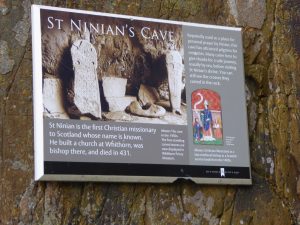 others the less physical visit to the reconstructed Bronze Age roundhouse and the museum, and for all, if so inclined, a visit to the Chapel in Isle of Whithorn.
others the less physical visit to the reconstructed Bronze Age roundhouse and the museum, and for all, if so inclined, a visit to the Chapel in Isle of Whithorn.
Like most others, we set off for the cave. We started out a little later than others, after a search for petrol!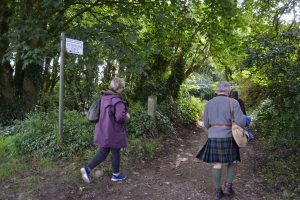 After the car park there was a trail down to the pebble beach; down a gulley, following a wee burn through a dark wood of trees that grew straight up towards the flashes of sunlight & blue sky, like a cathedral. As we walked there were glimpses of the glittering sea, until we emerged from the woods and the whole panorama came in view. It was wonderful to come out onto the beach of polished, smooth, rounded pebbles, sea sparkling – a warm breeze.
After the car park there was a trail down to the pebble beach; down a gulley, following a wee burn through a dark wood of trees that grew straight up towards the flashes of sunlight & blue sky, like a cathedral. As we walked there were glimpses of the glittering sea, until we emerged from the woods and the whole panorama came in view. It was wonderful to come out onto the beach of polished, smooth, rounded pebbles, sea sparkling – a warm breeze.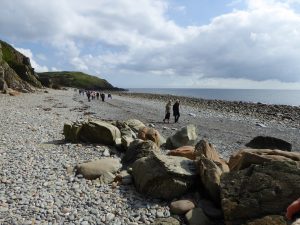
We sat for our picnic lunch on a grassy hummock above the beach, ate our sarnies, and just admired the sea, and soaked up the sun – the huge mass of the Isle of Man , then the Rinns of Galloway in the other direction. Gorgeous day, just to sit and enjoy. We didn’t want to move —-some places give you that sense, for a little while, of stepping out of time, this was one such place.
Eventually we walked over to at the cave itself. In the cliff side at the far end of the beach it has a dramatic presentation. 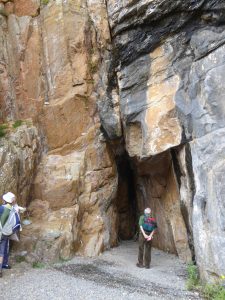 Above the quite shallow cave is a great slab of rock looking like a portcullis drawn up. As we approached the cave, we noticed the drift wood cross someone had stuck into the cliff side above it. Other little crosses, made of twigs, small bits of wood, roughly bound together are all around the place. Stones, rocks with names written on them, articles of remembrance, of not forgetting.
Above the quite shallow cave is a great slab of rock looking like a portcullis drawn up. As we approached the cave, we noticed the drift wood cross someone had stuck into the cliff side above it. Other little crosses, made of twigs, small bits of wood, roughly bound together are all around the place. Stones, rocks with names written on them, articles of remembrance, of not forgetting.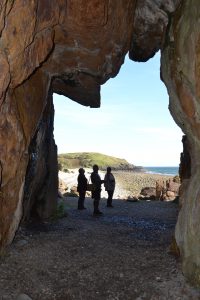 On a smooth rock surface to the left of the cave, people had carved names and messages, seemingly for generations, dedicated to St. Ninian, dedicated to God. There was a sense of other healing shrines like Lourdes. In such places people who have been healed leave behind the symbols of the illness overcome, crutches, tokens of disease of one sort or another. Here people left behind stones and cairns and names, the bones of a story, signs and symbols of spiritual need, spiritual healing.
On a smooth rock surface to the left of the cave, people had carved names and messages, seemingly for generations, dedicated to St. Ninian, dedicated to God. There was a sense of other healing shrines like Lourdes. In such places people who have been healed leave behind the symbols of the illness overcome, crutches, tokens of disease of one sort or another. Here people left behind stones and cairns and names, the bones of a story, signs and symbols of spiritual need, spiritual healing.
God gifts us beauty in the midst of the beauty of the natural world, a gracedness in what we see and in what we recognise as being a gift to us. We looked up, and directly above the cave mouth, saw a solitary raven in the sky – in the joy of the day, we watched it close its wings and stoop into a dive, then flick them open and do a barrel roll in the air. Several times we saw and watched. Then other members of the raven family arrived and we watched them riding on the wind as it came off the escarpment above us. Magic, but not magic – grace.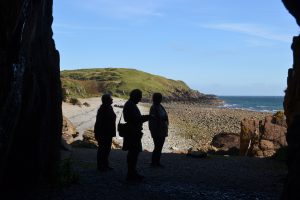
We stood in Ninian’s cave; where, we believe, he sought the peace and solace of the wild place in order to pray, and prayed ourselves.
We had been pilgrims, on a journey, learning to understand the meaning of love, learning to love one another, learning to love God.
 This is what the pilgrimage is about, nothing else matters, as we move to the end of our journey, as we finally approach God everything else falls away, only love is left.
This is what the pilgrimage is about, nothing else matters, as we move to the end of our journey, as we finally approach God everything else falls away, only love is left.
Maggie Macleod and Elizabeth McDonnell

